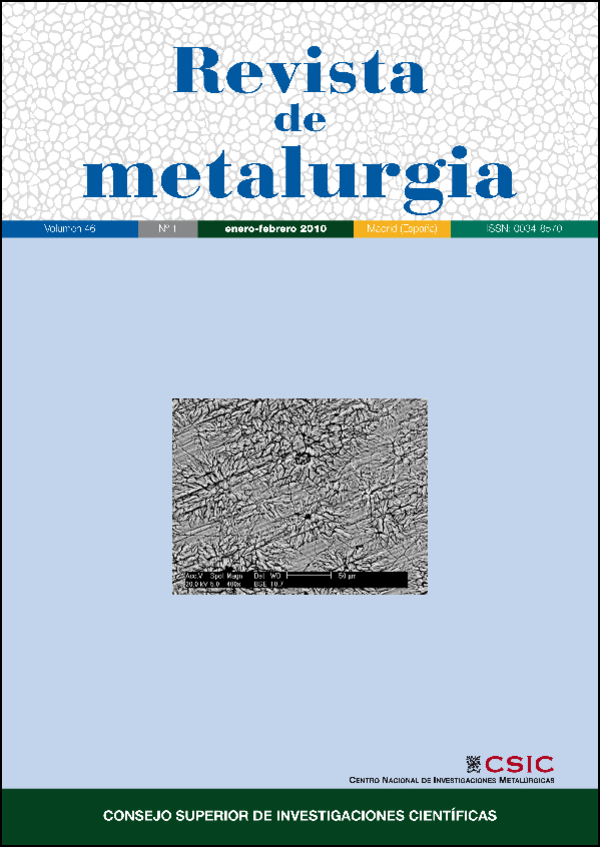Neural network based prediction of roughing and finishing times in a hot strip mill
DOI:
https://doi.org/10.3989/revmetalm.0850Keywords:
Hot rolling steel, Slab, Coil, Mill pacing, Neural networksAbstract
The paper presents a model based on neural networks which is able to predict the time required to pass the different gauges of a roughing and finishing mill as function of some slab features and process parameters. The final aim of the work is to increase the rolling efficiency while avoiding collisions and queues that cause time and energy losses. Neural networks are suitable to this prediction task as they are particularly able to cope with unknown non linear relationships between input and output variables. Moreover they can learn from real industrial data and therefore do not require prior assumptions or mathematical modelling of the process and transferability is ensured by the possibility to use different databases coming from different rolling mills. In the paper, two different kinds of neural network- based models have been proposed, their performances have been discussed and compared.
Downloads
References
[1] S. Sasaka, Y. Kozaki, Y. Chida, T. Kotake, F. Fukuda and T. Satoh, ISIJ Int. 30 (1990) 161-166. doi:10.2355/isijinternational.30.161
[2] O. Michinori, 111th ISIJ Meeting, Vol. 72 (4), Tokyo, Japan, 1986, pp. S330.
[3] J. Katzberg and Q. Li, Proc. IEEE Communications, Power, and Computing Conf. WESCANEX’95. Vol. 2, Winnipeg, Man., Canada, 1995, IEEE Service Center, Piscataway NJ, pp. 344-348.
[4] Y.S. Kim, B.J. Yum andM. Kim, Proc. 2001 Int. Joint Conf. Neural Networks IJCNN 2001, Washington DC, USA, 2001, pp. 2800-2804.
[5] H. Tamler and I. Jaeckel, BRITE/EURAM-project BE96-3061.
[6] Y. Bissessur, E.B. Martin, A.J. Morris and P. Kitston, IEE Proc. Control Theory Appl., Vol. 147, No. 6, 2000, IET, Stevenage, UK, 2001, pp. 633-640.
[7] S. Guan, H.X. Li and S.K. Tso, IEEE Trans. Contr. Syst. Technol. 9 (2001), 348-356. doi:10.1109/87.911386
[8] C. Dumortier and P. Lehert, ISIJ Int. 39 (1999) 980-985. doi:10.2355/isijinternational.39.980
[9] R. Valentini, V. Colla, M. Sgarbi and L.M. Reyneri, Rev. Metal. Madrid, Vol. Extr. (2005) 314-317.
[10] D. Dunne, H. Tsuei and Z. Sterjovski, ISIJ Int. 44 (2004) 1599-1607. doi:10.2355/isijinternational.44.1599
[11] J. Warde and D.M. Knowles, ISIJ Int. 39 (1999)1006-1014. doi:10.2355/isijinternational.39.1006
[12] R. Valentini, V. Colla and M. Vannucci, Rev. Metal. Madrid 40 (2004) 416-419.
[13] J.M. Vitek, ISIJ Int. 39 (1999) 1088-1095. doi:10.2355/isijinternational.39.1088
[14] J. Aylen, Ironmak. Steelmak. 31 (2004) 466. doi:10.1179/030192304225019324
[15] R.P. Bhagat, H.S. Ray and S.K. Gupta, ISIJ Int. 31 (1991) 669-676. doi:10.2355/isijinternational.31.669
[16] S. Cateni, V. Colla andM. Vannucci, AIA 2007 Conf., Innsbruck, Austria, 2007, Vladan Devedzic (Ed.), IASTED/ACTA Press, Calgary, Canada, 2007, pp. 605-610.
[17] T. T. Soong, Fundamentals of probability and statistics for engineers, John Wiley & Sons Ed., Chichester. England, 2004.
[18] D. A. Sofge and D. L. Elliott, Proc. Conf. Neural Networks & Brain (NN&B’98-Beijing), Beijing, China 1998.
[19] I. Guyon, S. Gunn, M. Nikravesh and L.A. Zadeh, Feature extraction: foundations and applications”, Springer-Verlag, New York, USA, 2006. doi:10.1007/978-3-540-35488-8
Downloads
Published
How to Cite
Issue
Section
License
Copyright (c) 2010 Consejo Superior de Investigaciones Científicas (CSIC)

This work is licensed under a Creative Commons Attribution 4.0 International License.
© CSIC. Manuscripts published in both the printed and online versions of this Journal are the property of Consejo Superior de Investigaciones Científicas, and quoting this source is a requirement for any partial or full reproduction.
All contents of this electronic edition, except where otherwise noted, are distributed under a “Creative Commons Attribution 4.0 International” (CC BY 4.0) License. You may read the basic information and the legal text of the license. The indication of the CC BY 4.0 License must be expressly stated in this way when necessary.
Self-archiving in repositories, personal webpages or similar, of any version other than the published by the Editor, is not allowed.
















